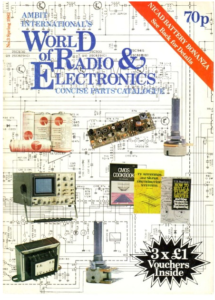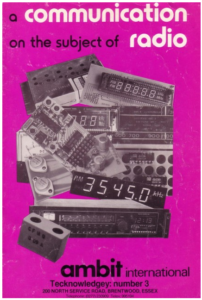 I’m sure there are many people out there who remember the electronics catalogues of old. They were slim and light enough to hold in your hand comfortably, seemed to contain all the components and parts you’d ever need…PLUS…they were full of information telling you how to use the parts.
I’m sure there are many people out there who remember the electronics catalogues of old. They were slim and light enough to hold in your hand comfortably, seemed to contain all the components and parts you’d ever need…PLUS…they were full of information telling you how to use the parts.
One of my most loved companies was Ambit International which later became Cirkit Distribution…I spent far too much money with these guys on components and kits. Their catalogues were goldmines…I still have some of them.
If you’d like to download copies of some of the Ambit catalogues, please get in touch as the original ‘usp.net/ambit’ page where the files were, is no longer available it seems..
Here’s the text part from the ‘usp.net’ website verbatim:
Ambit was a mail order company started in a Brentwood bedroom in the early 1970s, to provide those hard to get parts that radio and electronics enthusiasts struggled to find in the existing mail order catalogues of those times – which were still largely anchored in the world of bakelite knobs, filament bulbs and valves.
Ambit showed up on the scene just as bipolar transistors were getting a grip on RF transmit applications, and JFET and MOSFET signal devices were changing the face of radio receiver design along with varicap diodes Integrated circuits were beginning to amalgamate a wide range of functions for AM/FM and FM radio – including on board balanced mixers.
Digital displays were also just showing up – fluorescent and LED displays made the construction of radios a lot more precise and simpler, after a half century of cogs, cords, dials, and pointers.
We looked inside Japanese equipment and sourced the same TOKO coils, Murata and Uniden filters that Japanese manufacturers were using by the 100k, and made them available to the enthusiast and development lab in small volume. We supplied everyone involved in the electronics business that needed wireless parts in those days: the BBC, IBA, MoD, Marconi, Racal, Quad, A&R, Universities …you name it.
 Because we were offering parts parts that were not generally found in UK data reference books and catalogues – we had to create our own data, back in the days before desktop publishing. Below we offer links to 5 PDF editions of the early catalogues that contain data on many parts that are still being used in news designs, plus kits and building block modules. This was mostly a pre-digital era where the emphasis was on linear and analogue. The founders sold the business in the 80s, and then worked together on projects such as Amstrad’s computers during that golden age when Amstrad even outsold IBM in Europe, as affordable microcomputing really took off.
Because we were offering parts parts that were not generally found in UK data reference books and catalogues – we had to create our own data, back in the days before desktop publishing. Below we offer links to 5 PDF editions of the early catalogues that contain data on many parts that are still being used in news designs, plus kits and building block modules. This was mostly a pre-digital era where the emphasis was on linear and analogue. The founders sold the business in the 80s, and then worked together on projects such as Amstrad’s computers during that golden age when Amstrad even outsold IBM in Europe, as affordable microcomputing really took off.